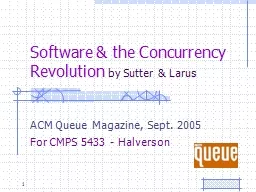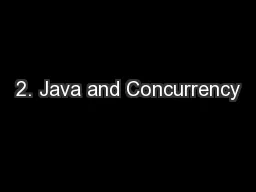PPT-Software & the Concurrency Revolution
Author : tatyana-admore | Published Date : 2019-12-13
Software amp the Concurrency Revolution by Sutter amp Larus ACM Queue Magazine Sept 2005 For CMPS 5433 Halverson 1 In a Nutshell The concurrency revolution is primarily
Presentation Embed Code
Download Presentation
Download Presentation The PPT/PDF document "Software & the Concurrency Revolutio..." is the property of its rightful owner. Permission is granted to download and print the materials on this website for personal, non-commercial use only, and to display it on your personal computer provided you do not modify the materials and that you retain all copyright notices contained in the materials. By downloading content from our website, you accept the terms of this agreement.
Software & the Concurrency Revolution: Transcript
Download Rules Of Document
"Software & the Concurrency Revolution"The content belongs to its owner. You may download and print it for personal use, without modification, and keep all copyright notices. By downloading, you agree to these terms.
Related Documents














